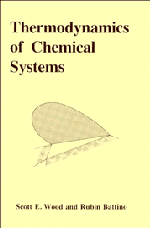Book contents
- Frontmatter
- Contents
- Preface
- Notation
- 1 Introduction
- 2 Temperature, heat, work, energy, and enthalpy
- 3 The second law of thermodynamics: the entropy function
- 4 Gibbs and Helmholtz energy functions and open systems
- 5 Conditions of equilibrium and stability: the phase rule
- 6 Partial molar quantities
- 7 Ideal gases and real gases
- 8 Liquids and solids: reference and standard states
- 9 Thermochemistry
- 10 Phase equilibrium
- 11 Chemical equilibrium
- 12 Equilibria in electrochemical systems
- 13 Surface effects
- 14 Equilibrium conditions in the presence of an external field
- 15 The third law of thermodynamics
- Appendices
- Cited references and selected bibliography
- Subject index
2 - Temperature, heat, work, energy, and enthalpy
Published online by Cambridge University Press: 28 October 2009
- Frontmatter
- Contents
- Preface
- Notation
- 1 Introduction
- 2 Temperature, heat, work, energy, and enthalpy
- 3 The second law of thermodynamics: the entropy function
- 4 Gibbs and Helmholtz energy functions and open systems
- 5 Conditions of equilibrium and stability: the phase rule
- 6 Partial molar quantities
- 7 Ideal gases and real gases
- 8 Liquids and solids: reference and standard states
- 9 Thermochemistry
- 10 Phase equilibrium
- 11 Chemical equilibrium
- 12 Equilibria in electrochemical systems
- 13 Surface effects
- 14 Equilibrium conditions in the presence of an external field
- 15 The third law of thermodynamics
- Appendices
- Cited references and selected bibliography
- Subject index
Summary
In this chapter we briefly review the ideas and equations relating to the important concepts of temperature, heat, work, energy, and enthalpy.
Temperature
The concept of temperature can be defined operationally; that is, in terms of a set of operations or conditions that define the concept. To define a temperature scale operationally we need: (1) one particular pure or defined substance; (2) a specific property of that substance that changes with a naive sense of ‘degree of hotness’ (i.e., temperature); (3) an equation relating temperature to the specific property; (4) a sufficient number of fixed points (defined as reproducible temperatures) to evaluate the constants in the equation in (3); and (5) the assignment of numerical values to the fixed points. Historically, many different choices have been made with respect to the five conditions listed above, and this, of course, has resulted in many temperature scales.
The ideal gas temperature scale is of especial interest, since it can be directly related to the thermodynamic temperature scale (see Sect. 3.7). The typical constant-volume gas thermometer conforms to the thermodynamic temperature scale within about 0.01 K or less at agreed fixed points such as the triple point of oxygen and the freezing points of metals such as silver and gold. The thermodynamic temperature scale requires only one fixed point and is independent of the nature of the substance used in the defining Carnot cycle.
- Type
- Chapter
- Information
- Thermodynamics of Chemical Systems , pp. 6 - 23Publisher: Cambridge University PressPrint publication year: 1990



